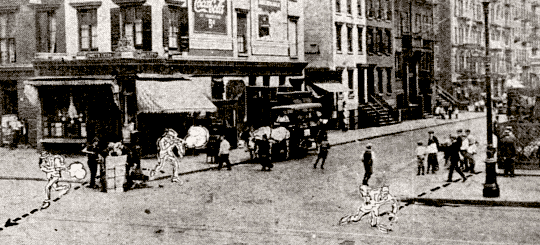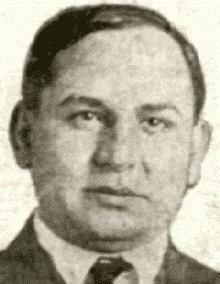On this date in 1900...
 |
| Bresci |
Gaetano Bresci, accused assassin of Italy's King Umberto I, stood trial August 29, 1900, in Milan's Palace of Justice. The trial was concluded in a single day. A jury unanimously found him guilty. Bresci was sentenced to life in prison (the greatest punishment then allowed under Italian law), with the first seven years to be spent in solitary confinement and the rest to be spent in penal servitude.
King Umberto was shot to death in front of numerous witnesses at Monza on July 29. As the monarch concluded an appearance at an athletic awards presentation, three bullets were fired from point-blank range into his neck and chest.
Bresci, with a smoking revolver still in his hand, was attacked by the crowd. A force of
carabinieri police rushed in to take custody of Bresci, likely saving him from a beating death at the hands of the angry mob.
The authorities identified their prisoner and learned that he was born in Prato, near Florence, on November 10, 1869. Though raised in a family with no known Leftist leanings, Bresci reportedly was influenced by the teachings of Italian anarchist Errico Malatesta and became a radical opponent of the political and religious establishments of his day. Records showed that he was imprisoned for about two weeks in 1892 after disregarding police instructions during an Italian labor strike.
Further radicalized in U.S.
 |
| La Questione Sociale HQ |
He subsequently sailed for America, settling in the Paterson, New Jersey, area, then the center of the United States textile industry as well as of a growing anarchist-communist movement. Paterson was the home of the
Gruppo Diritto all'Esistenza (Right to Existence Group) anarchist organization. The organization's newspaper,
La Questione Sociale (The Social Issue), had an international readership.
Bresci worked in New Jersey silk mills, married mill worker Sophie Knieland and started a family during the few years he was in America. He spent much of his free time with the
Gruppo Diritto all'Esistenza.
His political thinking in the period moved further Left, leaving behind the teachings of Malatesta. He aligned himself with the political philosophy of recently deceased Carlo Cafiero and
La Questione Sociale editor Giuseppe Ciancabilla. That philosophy called for individual acts of violence against the establishment - referred to as "propaganda by the deed" - in an effort to trigger a worldwide worker revolution.
With little advance notice or explanation, Bresci said goodbye to his wife and young daughter in May 1900 and set sail back across the Atlantic to his native Italy. He was determined to energize the anarchist cause through a bloody deed of propaganda.
At trial in Milan
 |
| Umberto I |
Bresci's defense counsel at his August 29 trial was the influential radical Francesco Saverio Merlino. As the trial began, Merlino stated that his defense strategy would be to show why Leftists like Bresci considered the assassination of the king to be essential to curing social, economic and political ills in Italy. The attorney planned to recount the crimes of Umberto against his people and to portray Bresci's action as justifiable retaliation.
The court refused to allow Merlino to make any such arguments.
Bresci went to the witness stand in the afternoon. His testimony only aided the prosecution. He admitted to returning to Italy for the purpose of murdering the king. In the time between his return and the assassination, he practiced his marksmanship and prepared special bullets by carving notches into their tips and filling them with dirt, which he believed would make their wounds more deadly.
He readily admitted firing three shots into King Umberto "to avenge the misery of the people and my own." Bresci insisted that he planned and carried out the assassination "without advice or accomplices."
When the jury returned its guilty verdict, Bresci stated, "Sentence me. I am indifferent. I await the next revolution."
After sentencing, Bresci was taken from Milan to an old Bourbon prison on the island of Santo Stefano in the Tyrrhenan Sea. He was to serve his sentence there.
Martyr to anarchism
Bresci's "life" prison term lasted less than nine months. On May 21, 1901, he was found dead in his prison cell. Officials attributed his death to suicide. It was reported that he used a towel to hang himself. Guards discovered the word, "Vengeance," scratched into his cell wall.
 |
| Sophie Bresci |
Despite the official report, Leftists around the globe believed that the Italian authorities were responsible for Bresci's death.
Back in New Jersey, Sophie Knieland Bresci had recently given birth to a second child and, with the support of local radical organizations, had opened a boarding house in Cliffside Park. The young widow refused to accept the suicide account. She told the press that her husband had recently written to her and told her that prison guards were trying to talk him into killing himself. She said he was too strong to succumb.
(Shortly after Bresci's death, Sicilian Mafia leader Vito Cascio Ferro traveled to the United States. A political radical in his homeland, Cascio Ferro reportedly met with Sophie Knieland Bresci in New Jersey.)
Two strong anarchist groups in the region,
Gruppo Diritto all-Esistenza and
Gruppo L'Era Nuova (New Age Group) echoed Sophie's position.
La Questione Sociale openly accused the Italian government of deliberate murder.
Bresci became a martyr to the anarchist cause. The philosophy of initiating revolution through individual violent action won many converts. A young anarchist group based in East Harlem, New York, expressed its high regard for him by naming itself the Gaetano Bresci Circle. A short time later, that group waged war on the United States government and on prominent capitalists through a wave of terror bombings.
Read more:
Wrongly Executed? The Long-Forgotten Context of Charles Sberna's 1939 Electrocution" by Thomas Hunt
Visit:
Wrongly Executed? website.






































